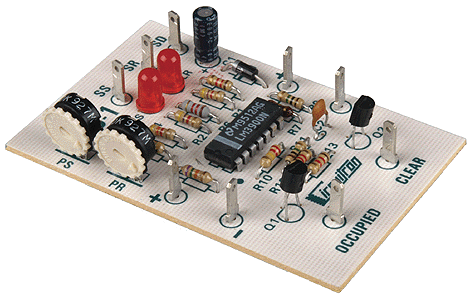Circuitron 5501 BD-1 Opto-Electronic Block Occupancy Detector All Scale
Circuitron 5501 BD-1 Opto-Electronic Block Occupancy Detector All Scale is backordered and will ship as soon as it is back in stock.
Couldn't load pickup availability
Description
Description
Circuitron 5201 DT-1 Grade Crossing Detector All Scale
Circuitron BD-1 Opto-Electronic Block Occupancy Detector ~ 5501
The CIRCUITRON BD-1 is an advanced, integrated circuit design Block Occupancy
Detector operating on a photo-electronic principle that provides positive indication whenever a section of a layout is occupied by any piece of rolling stock. CIRCUITRON Opto-Sensors are mounted between the ties at the end points of the block to be protected. Any piece of rolling stock entering the block shades the Opto-Sensors from
ambient room light which then activates the logic circuitry on the BD-1 circuit board. There are no modifications to the rolling stock necessary. The BD-1 is completely bi-directional and will give proper indications even if a train leaves a block by reversing direction and backing out. The CIRCUITRON BD-1 also contains all the driver
circuitry necessary to power two-color LED or incandescent lamp block signals at each end of the protected block. The BD-1 has a 250 ma. output driving capacity. The BD-1HD can handle 500 ma. on each output. For 3 color signaling, additional signal drivers will be necessary. The BD-1 requires a 10-18 volt DC input for proper operation. The power supply must be filtered. If you do not have a filtered power supply, the CIRCUITRON PS-1 filtered AC to DC Converter is ideal for this application.
INSTRUCTIONS: Please refer to the diagram for labeling and Opto-Sensor locations. The BD-1 can be connected with .110″ solderless connectors or by soldering leads directly to the terminals on the printed circuit board. If soldering, use a small pencil-type iron and electronics-grade rosin core 60/40 solder (available at Radio Shack). Use only as much heat as necessary to obtain a good joint and do not wiggle the terminal until the
solder has cooled completely.
1) Mount the circuit board in a convenient location. A section of CIRCUITRON’s PCMT makes this a simple task, or the mounting pads in the corners of the board may be drilled out and the circuit mounted with screws. If more than one BD-1 is going to be used, they can be mounted in rows for convenient bussing of the power supply connections between circuit boards. With a 12 volt DC power supply, a maximum of
6 BD-1’s can be bussed together. The reason for this is that there is a a 0.7 volt drop per board.
Exceeding 6 boards connected together may result in insufficient voltage for proper operation of all units.
2) Following the installation instructions packaged with the Opto-Sensors, install two Opto-Sensors at each end of the block you wish to protect. The actual length of the block does not matter, but it is important that the room lighting be the same at each end of the block. We recommend that you locate these OptoSensors 2 ties apart in HO Scale. Maintain a 1/2” separation in other scales.
3) Connect one lead from Opto-Sensor SSa to one lead of Opto-Sensor SSb using a light gauge (22-24) wire.
4) Connect one lead from Opto-Sensor SRa to one lead of Opto-Sensor SRb using light gauge wire.
5) Connect the remaining lead of Opto-Sensor SRa to the remaining lead of Opto-Sensor SSa and run a wire from this connection to the Sensor Drive terminal [SD] on the printed circuit board.
6) Run a wire from the remaining lead of Opto-Sensor SSb to the Sensor Set terminal [SS] on the printed circuit board.
7) Run a wire from the remaining lead of Opto-Sensor SRb to the Sensor Reset terminal [SR] on the printed circuit board.
8) Connect a source of filtered DC between 10 and 18 volts to the [+] and [-] Power Supply Terminals.
9) Connect the loads you wish to drive (lamps, LEDs, relays, etc.) between a positive DC source (this may be the same source that is powering the BD-1 or a separate DC supply) and the [OCCUPIED] and [CLEAR] terminals as shown. If you are using LEDs, you must include resistors as shown. Please note that the outputs of the BD-1 provide a ground or common connection and that all loads are connected to the positive supply.
NOTE: If you are utilizing a separate DC power source for your lamps, the negative (-) side of this power source must be connected to the negative (-) side of the BD-1 power source for proper operation.
DO NOT EXCEED 250 ma LOAD (500 ma for the BD-1HD) ON EITHER OUTPUT UNDER ANY CONDITIONS.
ADJUSTMENTS: All adjustments should be made with the room lighting at the level it will be at during operating sessions of the layout. Changes of room lighting may necessitate readjustment of the sensitivity controls.
1) Making certain that no piece of rolling stock is shading any of the Opto-Sensors, rotate the Set Sensitivity Adjuster (PS) until the Set Indicator (LS) comes on. Rotate PS back until LS just turns off.
2) Repeat Step 1 for the Reset Sensitivity Adjuster (PR) and Reset indicator (LR).
3) The BD-1 should now be properly adjusted. Run a train through the block and observe the signals. If they do not indicate red (occupied) whenever a piece of rolling stock is within the block, repeat steps 1 and 2 above. If you notice any flickering of the indications, you do not have the adjustments quite sensitive enough. Again, repeat steps 1 and 2 above.
Specifications
Specifications
-
Scale-
-
Product Type-
-
Height
-
Width
-
Depth



